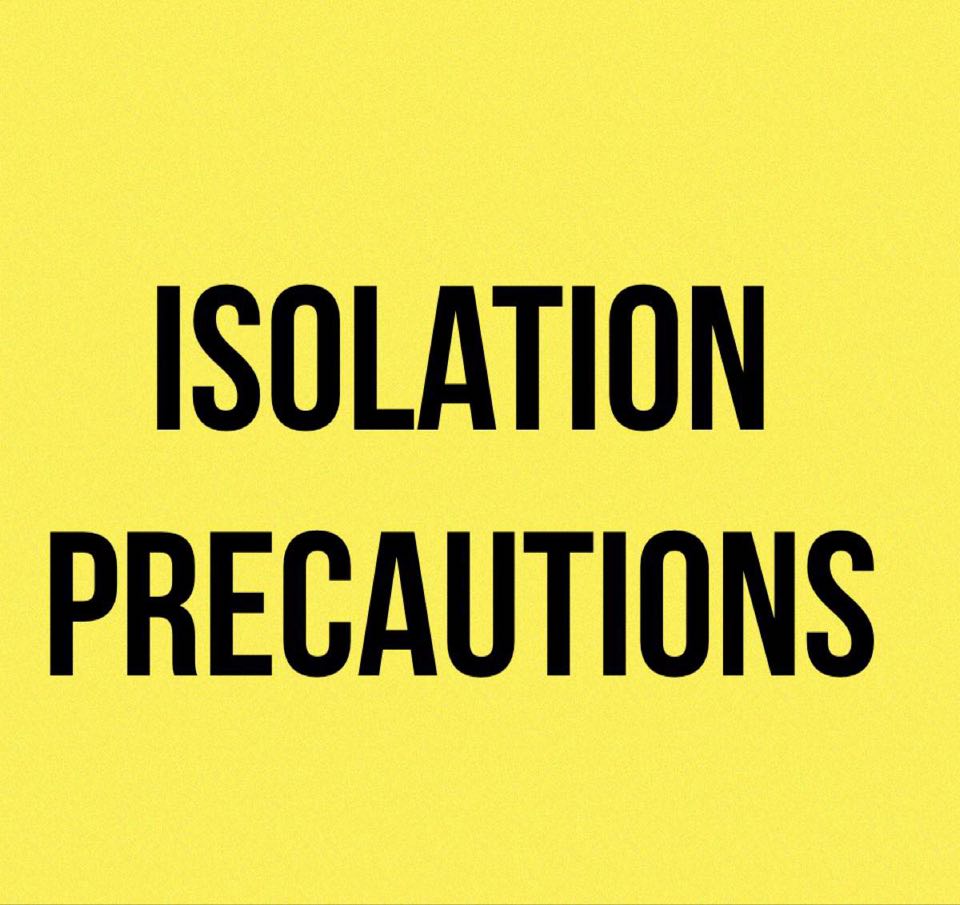
When a person has or is suspected of having a harmful, contagious disease, Isolation Precautions are taken to prevent the spread of these diseases in the hospital. Isolation Precautions provide a barrier between the person and the disease-causing germs.
Below are the different types of precautionary measures that have to be practiced for different types of germs. These should be strictly observed in the hospital to prevent spreading diseases.
I. STANDARD PRECAUTIONS:
Standard precautions, formerly known as “Universal Precautions,” are the main preventive measures for the successful control of hospital-acquired infections. These types of precautionary measures should be practiced at all times with all patients in the hospital. They should also be practiced at home as well.
Hand washing:
Proper handwashing is the most important component of standard precautions. Thorough handwashing with an antimicrobial soap before and after patient care is one of the best ways to get rid of germs and prevent the spread of germs to others. Gloves should be removed before leaving the patient’s room, and hands washed.
At home:
- Wash your hands before, during, and after preparing food.
- After using the toilet.
- After changing diapers.
Personal protective equipment:
Gloves, gown, and protective eyewear are designed to prevent direct contact with a patient’s blood or body fluids, secretions, and excretions, non-intact skin, and mucous membranes regardless of their diagnosis.
II. CONTACT PRECAUTIONS:
In addition to Standard Precautions, Contact Precautions are used when a person has a contagious disease that can be spread by direct or indirect contact. You can get infected by direct physical contact, like touching the person’s infected site or body fluids or touching his contaminated equipment or touching what the infected person has touched or used.
The following measures are required for Contact Precautions:
- Place the patient in a private room.
- Make sure the Contact Precautions sign on the door is visible to everyone.
- Gloves are to be worn when entering the room and should be removed before leaving the room.
- Proper handwashing before and after every patient interaction.
- A gown, eye goggles, and gloves should be worn if you will be taking care of a patient’s infectious materials such as wound drainage or respiratory secretions. Gown and gloves should be removed before leaving the patient’s room, and hands washed thoroughly.
- Equipment should be properly cleaned and disinfected if it will be used with other patients.
- Notify every receiving department beforehand regarding patient isolation status, including the transporter.
Diseases that require Contact Precaution measures:
- Methicillin-Resistant S. aureus (MRSA)
- Vancomycin-Resistant Enterococcus (VRE)
- Clostridium difficile (C-Diff)
- Gastroenteritis
- Diarrhea of unknown cause
- Scabies
- Pediculosis (Head Lice)
- Unknown Skin Rash
III. DROPLET PRECAUTIONS:
In addition to Standard Precautions, Droplet precautions are used when a person has an infection that can be spread by droplets from talking, sneezing or coughing. You can also get infected when you touch the contaminated surfaces around the infected person.
Measures for Droplet Precautions:
- Proper Hand Washing before and after patient care.
- Put a sign on the door that is visible to everyone who has to enter the room.
- Eye protection and mask should be worn when entering the room and should be removed before leaving the room.
- The patient should have dedicated equipment like a stethoscope, blood pressure cuff, and thermometers. Avoid sharing them with other patients.
- The patient should wear a surgical mask when transporting, and inform everyone in the receiving area beforehand regarding patient isolation status including the transporter.
Diseases requiring Droplet Precautions:
- Meningitis
- Pneumonia
- Pertussis
- Streptococcal pharyngitis
- Mumps
- Influenza
- Rubella (German Measles)
- Rhinovirus (Common Cold)
- COVID-19
IV. AIRBORNE PRECAUTIONS:
In addition to Contact Precautions, Airborne Precautions are used for a patient that has an infection that can be spread via tiny droplets in the environment. These droplets can stay in the air for a long time.
Airborne Precautions measures:
1. Put a sign on the door that is visible to everyone who enters the door.
2. Keep all airborne precaution supplies outside the patient’s room in a cart.
3. Contact Precautions (as noted above) must be followed in conjunction with Airborne Precautions.
4. Personal respiratory protection – must be worn by all persons who enter the room.
- N95 respirator
Fit-testing must be done annually.
or
- Powered Air-Purifying Respirator (PAPR)
- If the patient has to leave the room for diagnostic tests, he should wear a surgical mask covering his nose and mouth, and staff must notify the receiving area beforehand about the patient’s isolation status, including the transporter.
5. Negative-Pressure Room – is designed with a ventilation system to maintain a flow of air into the room. Air flows from the hallways or any nearby areas, flows into the negative room, thus making sure that the harmful air cannot escape from the negative pressure room to other parts of the facility. The door should be kept closed to maintain the proper air pressure. If the facility does not have a Negative-Pressure Room, usually they place the person in a private room with the door closed, with a sign on the door visible to everyone who enters the room, until the person is transferred to another facility with a negative- pressure room. The room should have a complete disinfecting process performed after the patient is transferred.
6. Patient care equipment, like a stethoscope, blood pressure cuff, and thermometers should stay in the patient’s room and should not be shared with other patients.
Diseases that require Airborne Precautions
- Severe Acute Respiratory Syndrome (SARS).
- Varicella (chickenpox).
- Mycobacterium tuberculosis.
- Measles.
- COVID -19